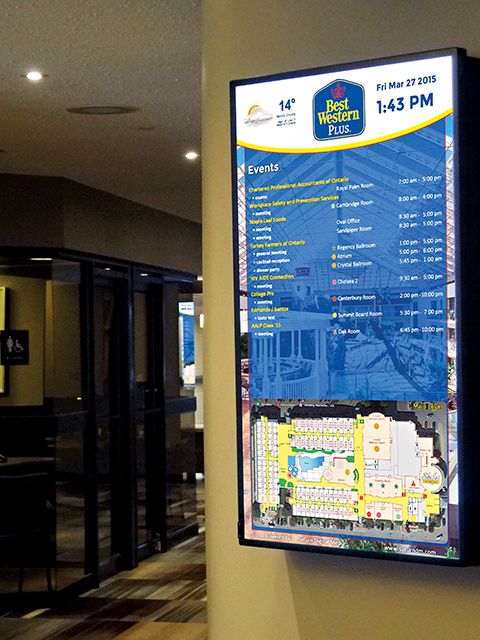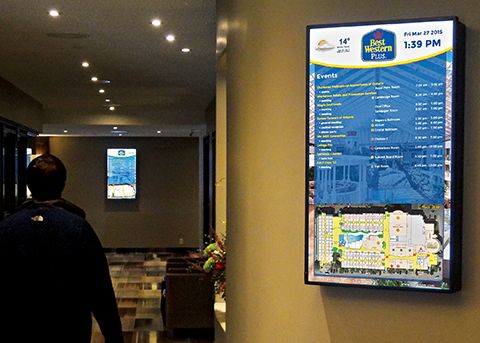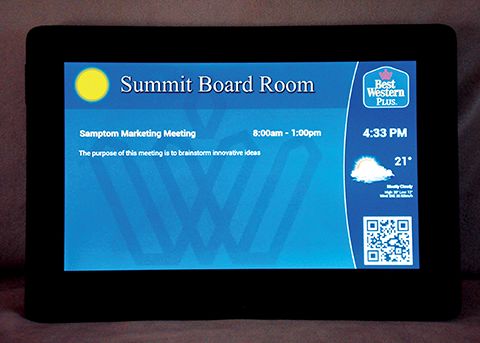Digital Signage: Designing more effective wayfinding
by all | 3 November 2015 11:35 am
 [1]
[1]Photos courtesy Saturn Digital Media
By Tom Graczkowski
As the old saying goes, a picture is worth a thousand words. This rings especially true when it comes to producing effective wayfinding sign systems. From a very young age, people learn to recognize colourful shapes and symbols that carry meanings, such as safety and restroom signs. Extensive research shows people are capable of committing huge amounts of information to memory by associating it with mental images.
An emphasis on visual communications is therefore essential for an effective wayfinding system. Nevertheless, it is surprising how many public facilities, hotels, hospitals, museums and other built environments offer little to no visual wayfinding for visitors.
Laying out routes
Wayfinding can be considered the planning stage of navigation, since its purpose is to lay out a route throughout a built environment or other space, so people can efficiently reach their destinations. As such, it requires the creation of a layout of a given space based on a cognitive map for solving location-based problems.
Another important aspect of wayfinding, of course, is to display maps and other types of information where visitors can see them. An information display helps people orient themselves within a new environment and then make definitive decisions for themselves, whether choosing an optimal route, finding a shortcut or planning a sequence of trips.
A good wayfinding system, therefore, should make each visitor aware of his/her location and how it relates to his/her destination. Visual cues, such as colours, recognizable features and clearly marked pathways, will help visitors successfully get to their destinations. The use of internationally recognizable symbols is particularly helpful in breaking down language barriers and, for that matter, communicating with people who cannot read, have a disability and/or are too embarrassed to ask for assistance.
The risks of poor wayfinding
In a good wayfinding system, the information should be accurate, precise and up-to-date, yet also simple enough so it does not become confusing. New visitors are calmed when they can access sufficient amounts of clear information, as this reassures them they will reach their destinations easily.
Without such access, studies show disorientation can lead to stress, feelings of helplessness, headaches, raised blood pressure and fatigue. When these symptoms are prolonged, the visitor may feel threatened. Bad wayfinding creates bad experiences, including real risks in cases of emergencies where people become alarmed but do not know what to do and where to go.
Good wayfinding, on the other hand, communicates to visitors that a facility is well-organized and professional. It not only promotes the facility as a capable place, but also reduces the stress and frustration associated with poor wayfinding, such that visitors will feel more open and trusting.
 [2]
[2]The Best Western Plus Lamplighter Inn and Conference Centre in London, Ont., has installed digital wayfinding signs at three key entrances.
Best Western gets better
The Best Western Plus Lamplighter Inn and Conference Centre in London, Ont., realized the need for an effective wayfinding design for its 15 meeting rooms, which are capable of accommodating groups of eight to 800 people, across more than 1,858 m2 (20,000 sf) of indoor space. Its objective was to implement a flexible, visually driven event scheduling system that would tie in with wayfinding signage to help visitors easily find their way around the property and to the right meetings.
The facility installed 1.2-m (46-in.) digital signage ‘reader boards’ at three key entrances, driven by media players to display event schedules, hotel information and wayfinding messaging. A custom layout was designed that interfaced with a secure Google Calendar.
This way, as the Lamplighter employees were already familiar with Google Calendar, it did not take much time for them to learn how to prepare event schedules in advance and make content updates as needed. And it was convenient to be able to do so from anywhere with Internet access, rather than being tied to any particular computer.
And once set, the digital signage runs on ‘autopilot,’ providing easy-to-read schedules and relevant ‘breakout’ content to guide visitors to their various meeting rooms. After they expire, both the event listings and their breakout content are removed from the reader boards, making room for additional information. And if all loaded events expire, the screens simply focus on the Lamplighter’s basic wayfinding information and messages that do not change.
The system also takes advantage of the brain’s preference for images over text, as alluded to earlier, by automatically displaying unique shapes and colours for each event and to indicate their respective locations on a map. Also, any of the default marker pairs can be temporarily replaced with the logo of the company hosting the event, at the hotel’s choosing, and then when that event expires, the logo will automatically be replaced by the default marker pair again.
Associating visual markers with meeting rooms makes it much quicker and easier for visitors to find their locations in listings and on maps. The graphics are especially useful when they are repeated on screens en route to and near the meeting room in question.
“The project looks better than I imagined,” says one Lamplighter manager. “It provides our guests with a unique and informative experience.”
 [3]
[3]With digital signage, time-sensitive wayfinding information, such as event listings, can be managed remotely.
Digital advantages
These aspects of the Lamplighter’s wayfinding system point to the advantages of digital over static signage. The ability to add and change graphics can help communicate themes to visitors, particularly when the artwork is easily recognizable. Without such features, they may not have enough information to decide their course of action.
Good wayfinding creates a good experience by giving visitors a strong indication of where they are and how to get to where they need to be. Bad wayfinding, on the other hand, creates a bad experience not only for visitors, but also for the facility, as employees will end up being pulled away from their regular tasks to assist lost visitors, reducing staff productivity. Further, if visitors become so frustrated with the environment that they leave and vow never to return again, then the ineffective wayfinding system is clearly bad for business.
The installation of digital screens can also expand an existing wayfinding system. In a conference facility, for example, small screens might be added to meeting room doors, to automatically display event names and short agendas where they are highly relevant, along with markers corresponding to graphics on digital maps elsewhere. In this way, screens become both visual cues for orientation and informational in nature.
Further, employees no longer have to print up sheets with event names, post them by hand near each meeting room every day and then remove them. Rather, all information can be updated and managed from a single, central location, which is especially helpful for large, complex facilities, such as hospitals. Wayfinding, after all, is not static; it is dynamic, based on the changing needs of the facility and its visitors.
 [4]
[4]Individual rooms can be equipped with their own small-format digital signs to list meetings and related information.
Another advantage of digital signage is interactivity. A visitor might scan a Quick Response (QR) code with a mobile device to check customized information on his/her location in relation to his/her destination. A tap of a touch screen can bring up a map for the entire route, along with dynamic arrows pointing in the right direction.
Preventing disorientation
At the end of the day, a good wayfinding system is appropriate to the facility and helps create a positive, stress-free experience for visitors. Maps need to be up-to-date, with clearly marked pathways to primary destinations. Graphics, symbols and other features need to be consistent, so as to provide effective visual cues.
When visitors understand the built environment around them, they feel a sense of empowerment and control. These are key factors for reducing anxiety, stress and disorientation.
Tom Graczkowski is creative director for Saturn Digital Media in London, Ont., which specializes in digital signage and media production services for hospitality, health-care, educational and corporate facilities. For more information, visit www.saturndm.com[5].
- [Image]: http://www.signmedia.ca/wp-content/uploads/2015/11/Best_Western_Wayfinding_DS_Cover.jpg
- [Image]: http://www.signmedia.ca/wp-content/uploads/2015/11/Best_Western_Lobby_Hall_Entrance_DS.jpg
- [Image]: http://www.signmedia.ca/wp-content/uploads/2015/11/Best_Western_Atrium_Entrance_DS2.jpg
- [Image]: http://www.signmedia.ca/wp-content/uploads/2015/11/Best_Western_Room_Screen.jpg
- www.saturndm.com: http://www.saturndm.com
Source URL: https://www.signmedia.ca/digital-signage-designing-more-effective-wayfinding/